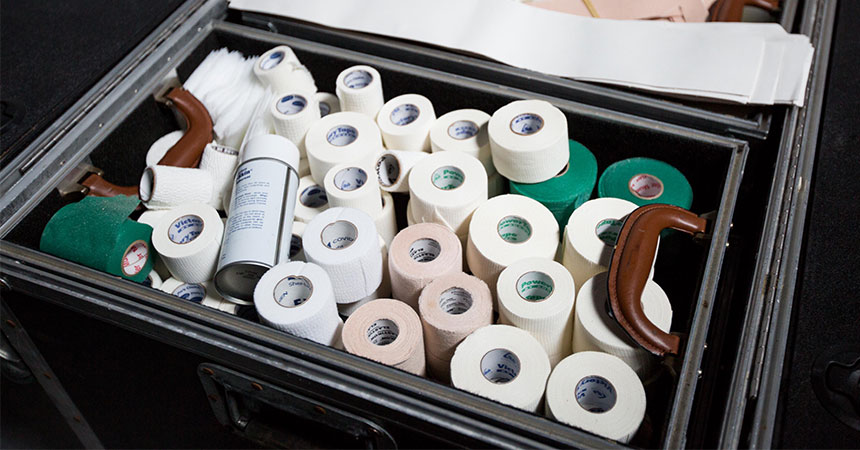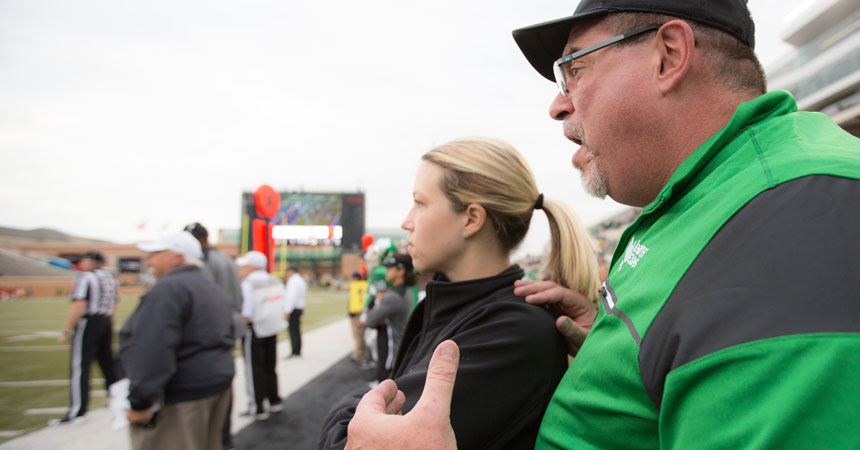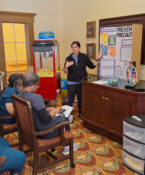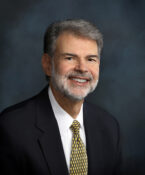For medical students, a sideline view of treating football injuries
By Alex Branch

University of North Texas quarterback Mason Fine faked a handoff and threw a perfect 60-yard touchdown pass to a streaking receiver, and the Mean Green sideline erupted.
Players leaped off the bench, coaches pumped their fists and the cheerleaders hugged. Everyone instantly reacted except Michael Shaffer, DO, and Chelsea Horn, then a fourth-year medical student at UNT Health Science Center, who stared intently at the players on the field.
“We don’t celebrate until we make sure everyone gets up,” said Dr. Shaffer, the Lead Primary Care Physician for UNT Athletics.
As a student last year on a four-week medical training rotation, Horn’s job was to worry about the players’ health first, winning later. She trained with Dr. Shaffer, who attends all UNT home and away football games and all men’s and women’s home basketball games.
The game last season against the University of Texas at El Paso was part of an invaluable opportunity to help care for high-performance athletes who suffer everything from traumatic injuries to sore throats.
“It’s unique because you work with patients who are in peak physical condition, and it is your job to help get them back to the point where they can perform again,” said Dr. Horn, who has since graduated from UNTHSC’s Texas College of Osteopathic Medicine. “It feels great when you do that and get to watch them go out there and play.”
Game Day
The opportunity to treat competitive athletes appeals to many medical students, especially those who played sports in high school or college.
It’s great work, Dr. Shaffer said, but probably not as glamorous as some imagine. Twice a week, he holds a 7 a.m. clinic in the athletic training room. Injured or sick athletes from all sports come for treatment when they arrive to lift weights or get taped for practice.
In all, Dr. Shaffer shares responsibility for the health of 350 to 400 UNT athletes each year. That requires constant communication with a staff of 10 certified athletic trainers, who must maintain constant communication with coaches anxious to know who is healthy enough to play.
For the medical students, it’s an eye-opening model of collaboration.
“I’d say Dr. Shaffer and I talk about 10 times every day, sometimes before 6 a.m. and after 10 p.m.,” said Jeff Smith, UNT Senior Associate Athletic Director for Sports Medicine. “It’s basically one big communication network, and he is right in the middle.”
Restoring bodies to ‘normal’
Before the UTEP game last season, Horn joined Dr. Shaffer in the training room more than two hours before kickoff. Players, wearing football pants and compression shirts, stopped by with lingering aches or to receive osteopathic manipulative therapy (OMT).
OMT, a hands-on style of care that heals pain by moving muscles and joints using techniques including stretching, gentle pressure and resistance, is popular with players and coaches. One of the coaches even brought a relative by to receive treatment before the game.
“OMT is beneficial for the football players because the sport takes a toll on their bodies,” Horn said. “They are hit repeatedly every day, which affects their body mechanics. OMT helps to restore them to their physiologic ‘normal,’ allowing them to continue to perform at a high level.”
Landry Dorsett, now a fourth-year medical student who trained with Dr. Shaffer, said the experience helped him improve the OMT skills he’s learned in medical school. The broad range of athletes he helped treat at Dr. Shaffer’s weekly sports medicine clinics required a wide range of treatments.
“You have to figure out what injuries the players are most susceptible to or what movements they need to make based on their sport or position,” he said. “For example, a volleyball player who felt back pain every time she did an overhand serve.
“It took quite a few different approaches to figure out how to relive that pain,” he said.
Students also learn communication skills for treating high-performance athletes.
Most college athletes dream of playing professionally. Dr. Shaffer’s job requires him at times to break difficult news to players after they suffer serious injuries.
Some players react with denial. Others with resignation. Sometimes all Dr. Shaffer can do is sit quietly while they drop their heads and cry.
Unforgettable experience
The Mean Green beat UTEP 45-10, and the band blared victorious tunes. Among the injuries treated by Dr. Shaffer and Horn were a cheerleader who twisted her wrist and a football staff member bleeding from his knee after a player crashed into him.
The following Saturday – an electrifying 52-49 win over Army — would deliver a harsher toll with several players leaving the field with injuries.
Some students who have trained with Dr. Shaffer will pursue careers in sports medicine. Others, like Horn, have different specialties in mind.
She plans to practice emergency medicine and found the exposure to musculoskeletal injuries that occur in football a valuable learning tool.
“It’s an experience you don’t forget,” Horn said.




![Uyen Sa Nguyen Scaled[58]](https://www.unthsc.edu/newsroom/wp-content/uploads/sites/16/Uyen-Sa-Nguyen-scaled58-145x175.jpg)


Social media